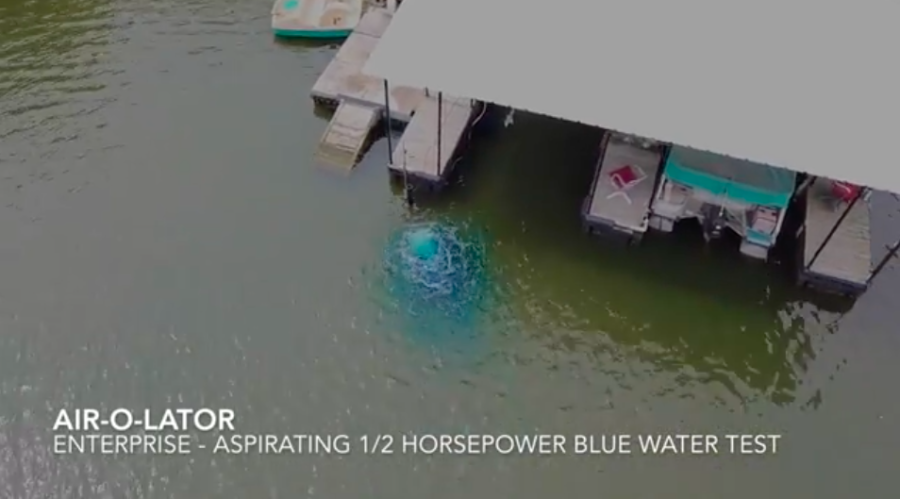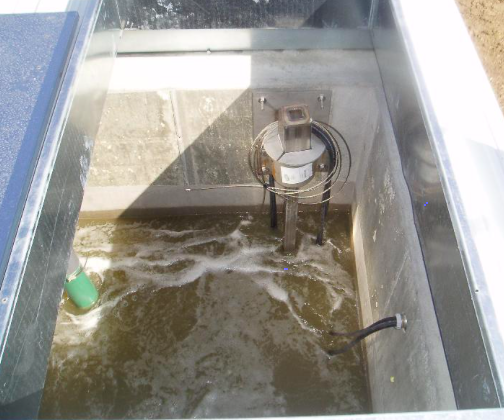Aspirators are used to provide horizontal directional flow, aeration, and mixing. They are fantastic energy and cost-efficient solutions for mixing, and help to increase flow and oxygen levels and improve water quality in any water application.
At Air-O-Lator, we offer two aspirating mixers that are an optimal solution for aerating and mixing water and wastewater. We have two systems: The Enterprise and the Enterprise II. Both units are designed with a submersible motor. With the submersible motors, the entire operating unit is below the water surface eliminating long shafts, deflection bushings, and bearings. Designed to operate in sub-zero temperatures eliminating the need for costly heating elements or covers. The Enterprise and Enterprise II are designed to be either mast mounted for tanks or floating for lagoons.
The Enterprise is available in ½ & 1 horsepower, single phase or ¾ & 1.5 horsepower three phase applications. The Enterprise is supplied with a Franklin Electric 4-inch submersible motor,
A 5-inch diameter propeller, 5-1/2 inch diameter venturi nozzle, and a 4-inch diameter air intake tube.
The Enterprise II is available in 3, 5, 7.5, or 10 horsepower, 230 volts, 1 phase or 230 volts, and 460 volts, 3 phase. The Enterprise II aspirating mixer is supplied with a Baldor/Reliance submersible motor explicitly designed for wastewater and hazardous locations. An 8-inch diameter propeller, an 8-1/2 inch diameter venturi nozzle, and a 4-inch air intake tube.
To successfully manage wastewater, an aspirating mixer must introduce and mix air into the water at a high volume to metabolize present aerobic microorganisms. The Enterprise Aspirating Mixer uses a high-volume axial flow propeller pump design that operates within a close tolerance throat. The high volume of water that is propelled from the throat and forced through a scientifically designed venturi nozzle, more than doubles the velocity of the fluid pumped, causing a low-pressure area to occur in the air intake chamber pulling air from the surface through the air intake tube. With tremendous force, the liquid and air converge inside the venturi nozzle and is discharged as a homogenous fine bubble mix of rapidly moving the aerated fluid.

Case Study: A Kawasaki plant in Maryville, MO finds a solution
 Sometimes the fix for one problem creates another. After the Kawasaki plant in Maryville, Missouri added a small processing plant to meet wastewater effluent discharge requirements, water management personnel discovered that aeration and mixing of the water were also needed. Air-O-Lator supplied two 7.5 horsepower Enterprise II aspirating mixers to solve the issue, maintaining aerobic condition for odor control.
Sometimes the fix for one problem creates another. After the Kawasaki plant in Maryville, Missouri added a small processing plant to meet wastewater effluent discharge requirements, water management personnel discovered that aeration and mixing of the water were also needed. Air-O-Lator supplied two 7.5 horsepower Enterprise II aspirating mixers to solve the issue, maintaining aerobic condition for odor control.
“It was imperative that we use heavy duty mixers for the industrial waste from the plant,” explained Brock Pfost, an engineer on the Kawasaki plant project. “The Enterprise II performed quite well. It provided more aeration than we needed, but it was a very easy fix (to get just the right amount of aeration).”
Compared to other mixers/aspirator brands, Pfost said his experience with Air-O-Lator exceeded his expectations. “The ability to use mixing and aeration made the process very efficient. An aspirator mixer compared to other systems is easier to maintain and service,” Pfost noted. He would rate the Enterprise II high based on efficiency, serviceability, maintenance, and cost.